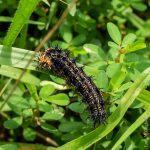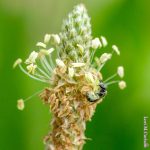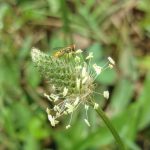Better Know a Host Plant is a series of posts all about common to rare butterfly host plants. Each week during the butterfly season we will feature a host plant that we have experience with, or just find interesting!
Common Name: Ribgrass Plantain, English Plantain, Ribwort Plantain
Latin Name: Plantago lanceolata
Bloom time: Spring through Fall
Sun: Full sun to part shade
Water: Drought tolerant
Height: 1-2 feet
Spread: 1-1.5 feet
Native: No
Host Plant: Common Buckeye
Nectar Plant: Attracts a variety of small pollinators
Color: White flowers
Our Experience: Once I realized we had a natural abundance of ribgrass plantain growing in our yard (along with other ‘weedy’ host plants) we stopped mowing our lawn. This plant is unfortunately regarded as a noxious weed that needs to be poisoned out of pristine lawns. It’s appearance is a bit shaggy and the flowers are not pronounced, but it does attract interesting teensy pollinator insects like the bee and hover fly captured in the photos below. The bee is about 8 mm in length as well as the hover fly.
Pros: Easily grown from seed, or may be naturally present in your lawn if allowed to revert back to a natural state. It can be aggressive so if you are wanting to keep it contained, it seems to grow well in a container. Especially if you are going to be using it solely for feeding Common Buckeyes. It will survive benign neglect and outright abuse.
Cons: There is no such thing as having just one plant. It’s not a showy or ornamental plant–rather ‘weedy’ in appearance.
Interesting Notes: Ribgrass Plantain is considered an herb that can be used to make teas or the leaves can be eaten.
Rating: 3 out of 5





 with Elementor
with Elementor